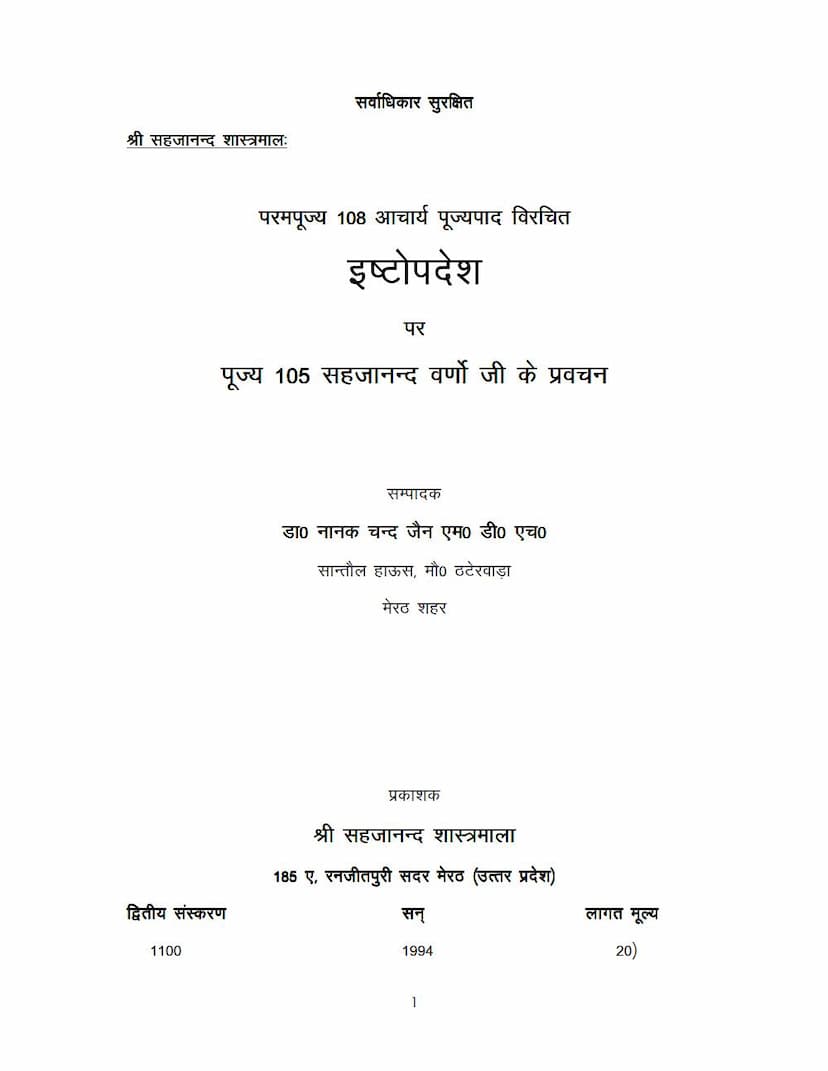Ishtopadesh
Added to library: September 1, 2025

Summary
The book "Ishtopadesh" by Sahajanand Maharaj is a commentary on the "Ishtopadesh" by Acharya Pujyapad. The preface highlights the prolific writing and simple language used by Sahajanand Maharaj to explain the works of great acharyas. This particular edition presents the second printing of Maharaj's discourses on Pujyapad Swami's 51-verse spiritual work, "Ishtopadesh."
The text begins with a mangalacharana (auspicious invocation) dedicating salutations to the Paramatma (Supreme Soul) who is of the form of Samyagjnana (right knowledge). The commentary clarifies that the soul is inherently knowledge-filled; the illusion of karma veils this inherent nature, and upon the removal of this veil, the soul naturally attains its true self. The divine nature is described as self-manifest (svayambhu) and achieved through self-realization, not external influence. The author of "Ishtopadesh" is identified as Pujyapada Swami, a master of various disciplines, including medicine, astrology, and grammar.
The core message of "Ishtopadesh" revolves around attaining ultimate happiness (ananda), which is intrinsically linked to knowledge, not material possessions. True wealth lies in the preservation of pure knowledge, free from any flaws or corruptions. The text explains that the attainment of the soul's inherent nature is not achieved through any external means but by the absence of obstructing karma. The soul's true nature, pure consciousness, is eternal and unchanging.
The book uses the analogy of a sculptor revealing a statue from a stone block to illustrate how the soul's inherent qualities are revealed by removing the veils of karma. The process involves stages of careful work, akin to spiritual practice, to chip away the obscuring elements.
The commentary elaborates on the concept of the soul's innate perfection and how misconceptions (like identifying with the body) create obstacles. It emphasizes the importance of bhedajnana (discrimination between the soul and non-soul elements) as a means to shed these misconceptions. This process involves stages of increasing awareness and careful practice.
The text then delves into the nature of the Paramatma, calling it Prabhu (Lord) and Vibhu (all-pervading). The vision of the Paramatma is described as being possible only through knowledge, and true peace is found in this vision. The importance of dedicating time to this spiritual pursuit is stressed, comparing the daily efforts of monks and devout laypeople.
The concept of an Adarsha (ideal) is discussed, stating that one aligns with what one cherishes. For those seeking self-interest, the pure soul is the ideal. The text highlights that true happiness and self-realization are achieved by understanding one's own true nature as pure knowledge, which also helps in weakening and eventually eradicating inner passions (kashayas).
The author differentiates between dravyakarma (material karma) and bhavakarma (mental karma), stating that the absence of both leads to the soul's natural state. While the absence of dravyakarma is a causal factor, the direct obstacle to the soul's manifestation is bhavakarma.
The text further explains the "how-to" of realizing one's true nature, using the analogy of transforming a stone into gold through appropriate processes. This requires the right elements—dravya (substance), kshetra (place), kala (time), and bhava (attitude)—to be in harmony. External practices like penance and adherence to vows contribute to purification and the eventual realization of the self.
The commentary emphasizes the role of right faith (samyaktva) and consistent practice in the spiritual journey. It clarifies that while external actions like vows are important, the internal understanding and detachment are crucial for true spiritual progress. The text strongly advocates for a life of virtue, highlighting that righteous actions lead to present and future well-being, while unrighteous actions bring misery.
The final verses of the commentary discuss the cyclical nature of karma and the soul's journey through different life forms. It stresses that the ultimate goal is liberation (moksha), and while heavenly pleasures (svarga) are temporary, the path to liberation is through knowledge, detachment, and self-realization. The text encourages readers to understand the impermanence of worldly pleasures and to focus on the eternal nature of the soul.